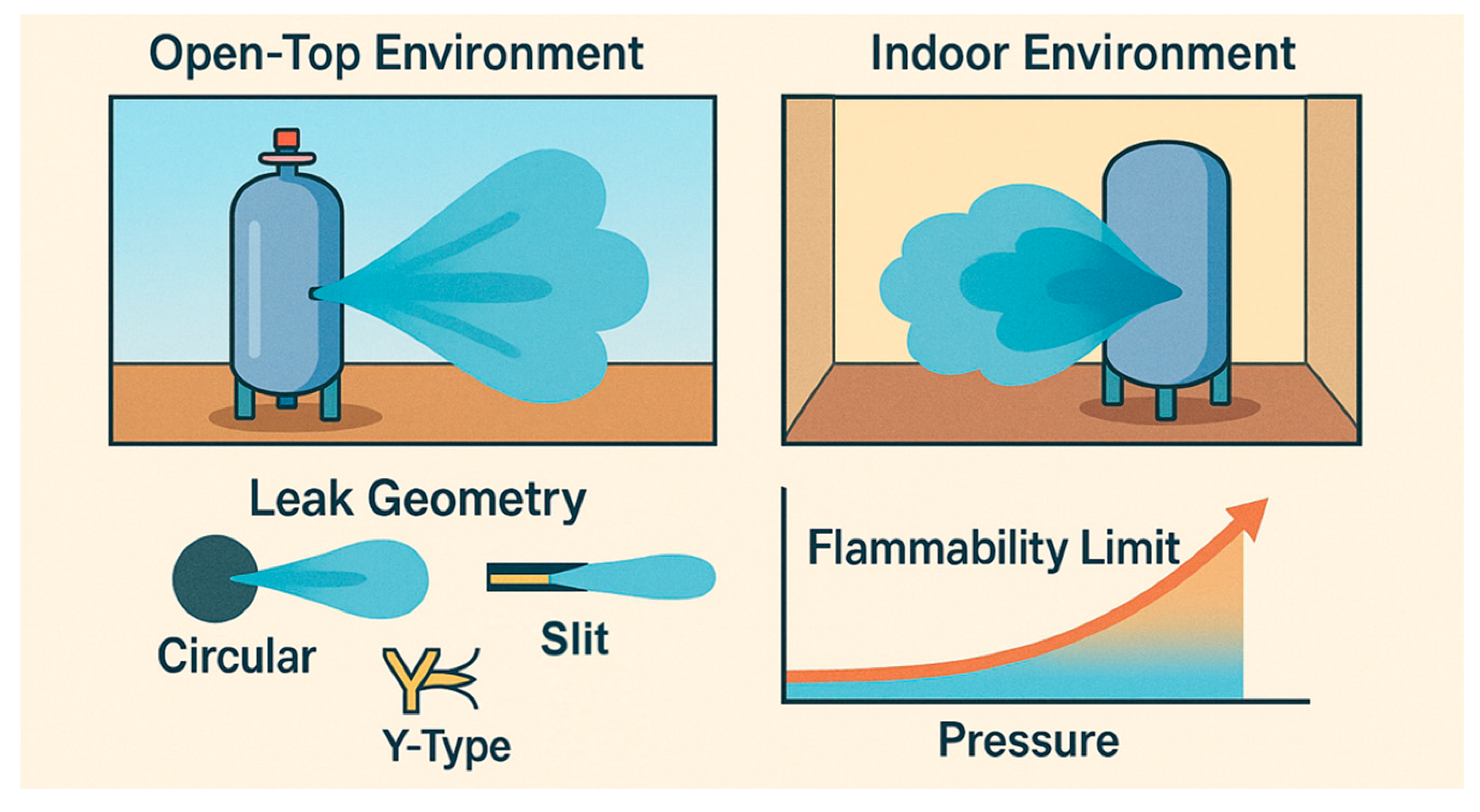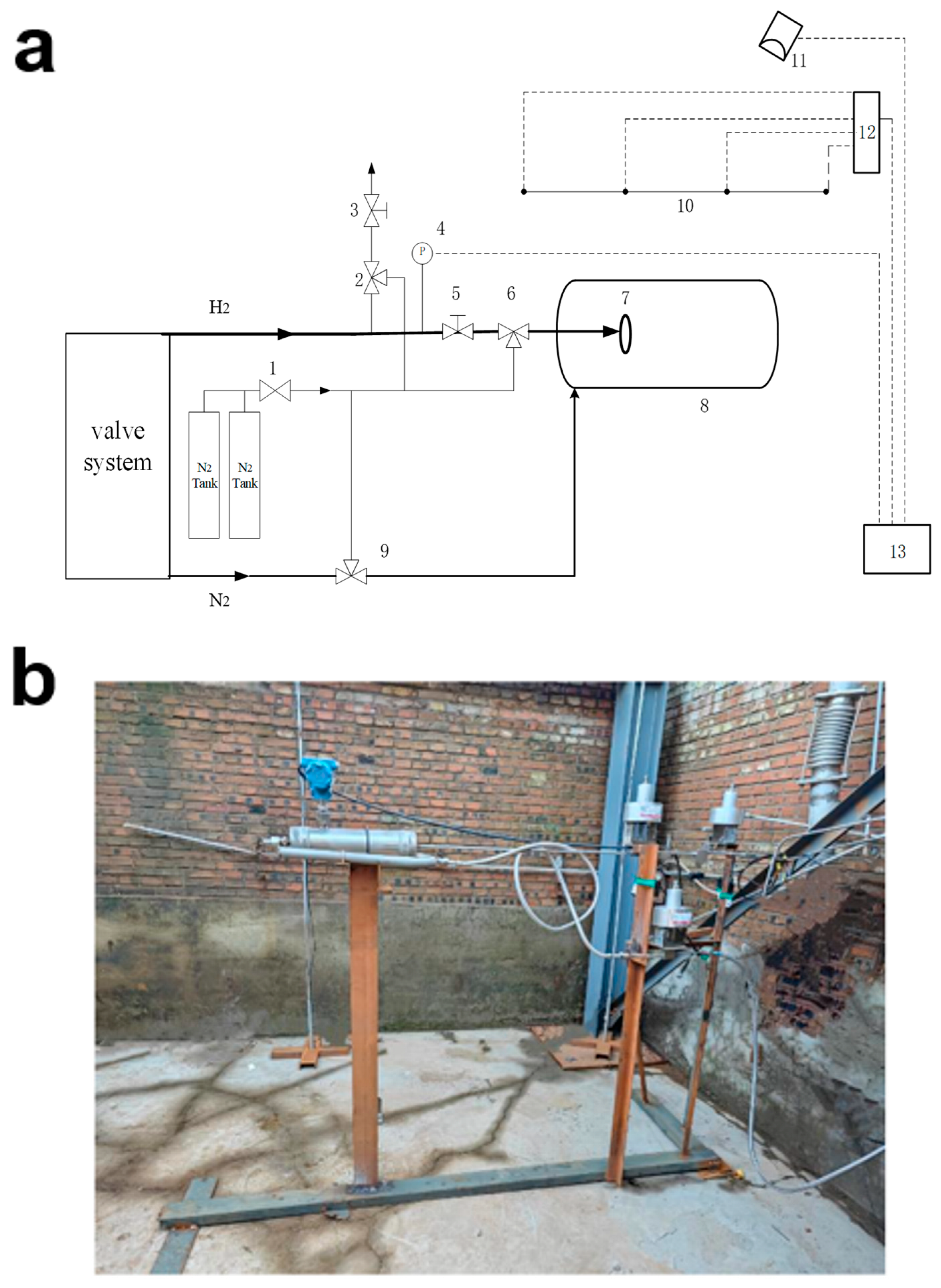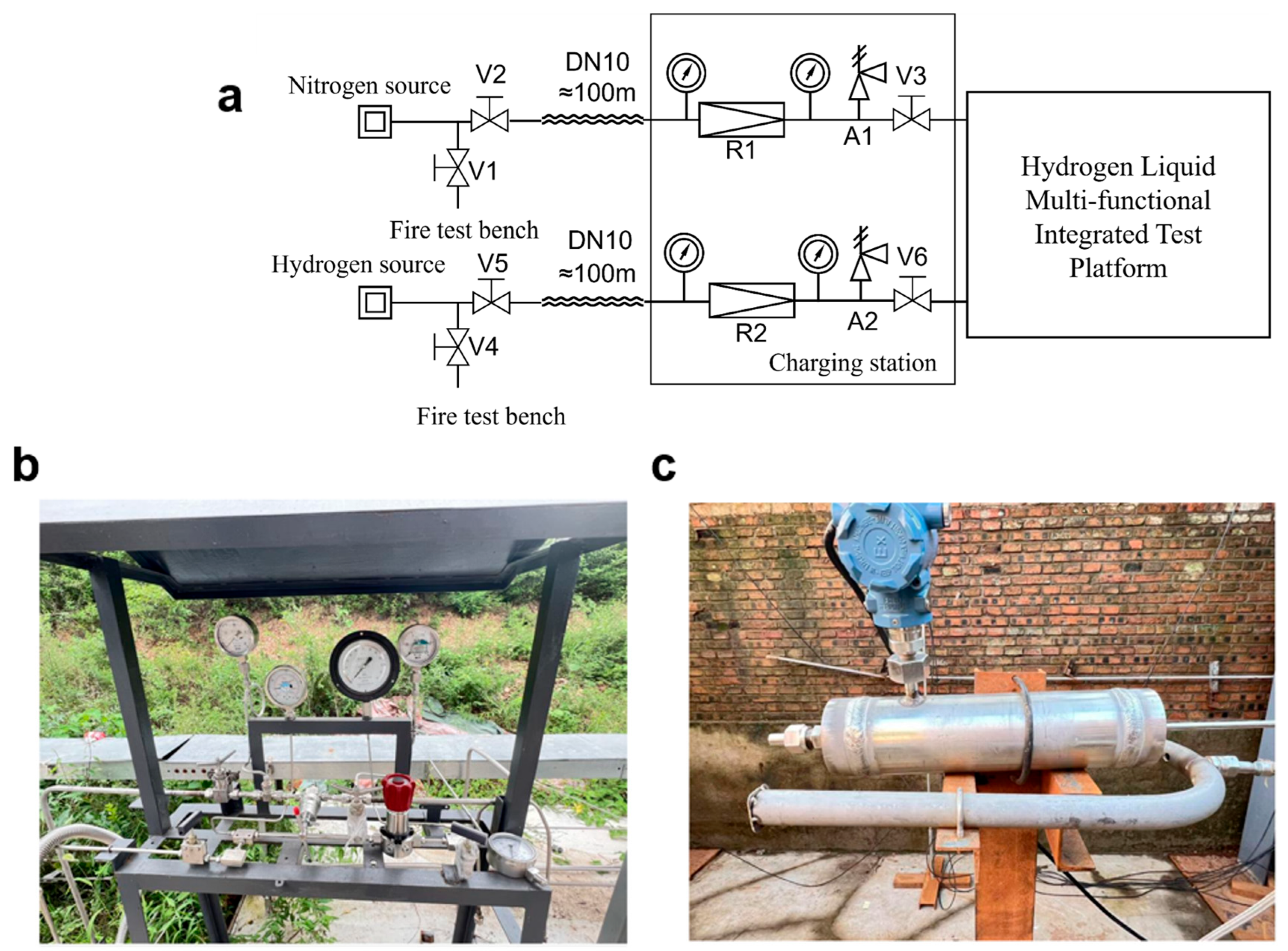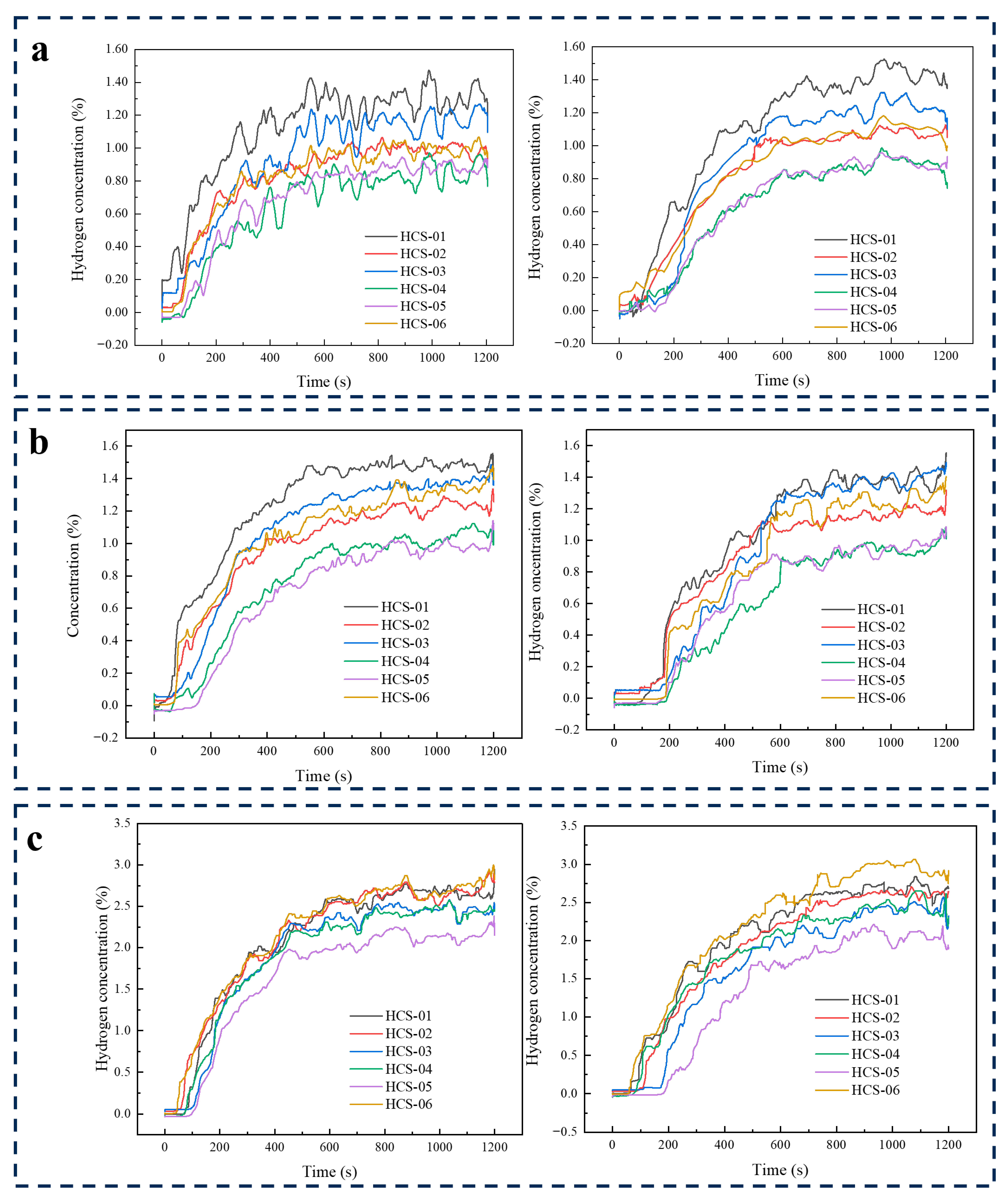Dispersion of High-Pressure Hydrogen Jets in Open-Top and Indoor Environments: Effects of Leak Geometry and Pressure
Abstract
1. Introduction
2. Hydrogen Leakage and Diffusion Test
2.1. Hydrogen Leakage and Diffusion Test System
2.2. Gas Distribution System
2.3. Remote Monitoring, Control, and Video System
2.4. Hydrogen Leakage Simulation Device
2.5. Nitrogen Fire Protection System
2.6. Hydrogen Concentration Monitoring System
3. Experimental Procedures
4. Results and Discussion
4.1. Indoor Hydrogen Leakage and Diffusion Test
4.1.1. Circular Hole Leakage Test
4.1.2. Slit-Type Leakage Hole Test
4.1.3. Y-Type Leakage Hole Test
4.2. Outdoor Hydrogen Leakage and Diffusion Test
4.2.1. Round Hole (0.5 mm, 3 MPa)
4.2.2. Slit (0.5 mm, 3 MPa)
4.2.3. Y-Type (0.5 mm, 3 MPa)
5. Conclusions and Perspectives
- (1)
- The geometry of leakage orifices markedly affects hydrogen concentration distribution. Circular orifices create directional jets with steep gradients and lower concentrations (e.g., 0.725% at 1 mm, sensor No. 6 vs. 0.45% at No. 3). Slit orifices yield orientation-dependent but more uniform diffusion, with concentrations rising to 2.625% at 1 mm. Y-type orifices generate multi-directional dispersion with the highest levels, reaching 2.9% at 0.5 mm and approaching the 4% LEL within 375 s at 1 mm. Their flow-splitting effect smooths gradients across positions but greatly elevates safety risks.
- (2)
- Equilibrium times increased with orifice size, but at different rates: circular orifices doubled from 400 s (0.1 mm) to 800 s (1 mm), slit orifices rose more slowly (600–800 s), while Y-type orifices required the longest times (900 s at 0.5 mm, with some 1 mm cases not reaching steady state). Response times for circular and slit orifices depended on distance from the jet core, whereas Y-type orifices showed overall shorter and more uniform responses (e.g., 10 s at 0.5 mm), reflecting rapid multi-directional dispersion.
- (3)
- Safety risks varied significantly with orifice geometry. Circular orifices produced the lowest concentrations (0.725% at 1 mm), offering greater margins; slit orifices reached higher levels (2.625% at 1 mm, about two-thirds of the LEL); and Y-type orifices posed the greatest hazard, with 2.9% at 0.5 mm and some 1 mm cases approaching the 4% LEL within minutes, requiring strict controls.
Author Contributions
Funding
Data Availability Statement
Conflicts of Interest
Abbreviations
| DAQ | data acquisition |
| FGCs | flammable gas clouds |
| HFCV | hydrogen fuel cell vehicles |
| PRVs | pressure-reducing valves |
| SRVs | safety relief valves |
References
- Boettcher, S.W. Introduction to Green Hydrogen. Chem. Rev. 2024, 124, 13095–13098. [Google Scholar] [CrossRef] [PubMed]
- Lyu, S.; Huang, X.; Peng, S.; Sun, M.; Qi, Q.; Aimaieraili, D. A novel method for analyzing the leakage and diffusion of hydrogen: First arrival time distribution. Renew. Sustain. Energy Rev. 2024, 198, 114451. [Google Scholar] [CrossRef]
- An, R.H.; Luo, S.F.; Zhou, H.S.; Zhang, Y.T.; Zhang, L.G.; Hu, H.L.; Li, P.X. Effects of hydrogen-rich water combined with vacuum precooling on the senescence and antioxidant capacity of pakchoi. Sci. Hortic. 2021, 289, 110469. [Google Scholar] [CrossRef]
- Anekwe, I.M.S.; Mustapha, S.I.; Akpasi, S.O.; Tetteh, E.K.; Joel, A.S.; Isa, Y.M. The hydrogen challenge: Addressing storage, safety, and environmental concerns in hydrogen economy. Int. J. Hydrogen Energy 2025, 167, 150952. [Google Scholar] [CrossRef]
- Wu, J.K.; Chen, S.; Yu, M.; Zhang, X.J.; Jiang, L. Techno-economic analysis on low-temperature and high-pressure cryo-adsorption hydrogen storage. Fuel 2025, 381, 133532. [Google Scholar] [CrossRef]
- Xu, X.; Xu, H.; Zheng, J.; Chen, L.; Wang, J. A high-efficiency liquid hydrogen storage system cooled by a fuel-cell-driven refrigerator for hydrogen combustion heat recovery. Energy Convers. Manag. 2020, 226, 113496. [Google Scholar] [CrossRef]
- Cui, W.; Yuan, Y.; Tong, L.; Shen, B. Numerical simulation of hydrogen leakage diffusion in seaport hydrogen refueling station. Int. J. Hydrogen Energy 2023, 48, 24521–24535. [Google Scholar] [CrossRef]
- Laghlimi, C.; Moutcine, A.; Ziat, Y.; Belkhanchi, H.; Koufi, A.; Bouyassan, S. Hydrogen, Chronology and Electrochemical Production. Solar Energy Sustain. Dev. J. 2024, 14, 22–37. [Google Scholar] [CrossRef]
- Lv, H.; Shen, Y.; Zheng, T.; Zhou, W.; Ming, P.; Zhang, C. Numerical study of hydrogen leakage, diffusion, and combustion in an outdoor parking space under different parking configurations. Renew. Sustain. Energy Rev. 2023, 173, 113093. [Google Scholar] [CrossRef]
- Huang, X.W.; Sun, W.; Li, Z.H.; Shi, J.Y.; Zhang, N.; Zhang, Y.; Zhai, X.D.; Hu, X.T.; Zou, X.B. Hydrogen sulfide gas sensing toward on-site monitoring of chilled meat spoilage based on ratio-type fluorescent probe. Food Chem. 2022, 396, 133654. [Google Scholar] [CrossRef] [PubMed]
- Liang, J.; Li, H.; Chen, L.; Ren, M.; Fakayode, O.A.; Han, J.; Zhou, C. Efficient hydrogen evolution reaction performance using lignin-assisted chestnut shell carbon-loaded molybdenum disulfide. Ind. Crops Prod. 2023, 193, 116214. [Google Scholar] [CrossRef]
- Li, X.; Liu, Z.; Shao, S.; Yu, Y.; Wang, W.; Sun, T.; Wu, S. A Ca-modified Ni/CeO2·Al2O3 bifunctional catalyst for two-stage steam reforming of biomass pyrolysis oil for hydrogen production. Ind. Crops Prod. 2025, 228, 120891. [Google Scholar] [CrossRef]
- Li, H.H.; Geng, W.H.; Sun, X.; Wei, W.Y.; Mu, X.F.; Ahmad, W.; Hassan, M.M.; Ouyang, Q.; Chen, Q.S. Fabricating a nano-bionic sensor for rapid detection of HS during pork spoilage using Ru NPs modulated catalytic hydrogenation conversion. Meat Sci. 2021, 177, 108507. [Google Scholar] [CrossRef]
- Yang, F.; Wang, T.; Deng, X.; Dang, J.; Huang, Z.; Hu, S.; Li, Y.; Ouyang, M. Review on hydrogen safety issues: Incident statistics, hydrogen diffusion, and detonation process. Int. J. Hydrogen Energy 2021, 46, 31467–31488. [Google Scholar] [CrossRef]
- Xiao, J.; Xu, N.; Cai, W.; Zhou, X.; Bénard, P.; Chahine, R.; Tong, L.; Yang, T. Thermodynamic and heat transfer models for refueling hydrogen vehicles: Formulation, validation and application. Int. J. Hydrogen Energy 2024, 52, 172–190. [Google Scholar] [CrossRef]
- Yang, N.; Deng, J.; Wang, C.; Bai, Z.; Qu, J. High pressure hydrogen leakage diffusion: Research progress. Int. J. Hydrogen Energy 2024, 50, 1029–1046. [Google Scholar] [CrossRef]
- Qin, C.; Tian, Y.; Yang, Z.; Hao, D.; Feng, L. Quantitative analysis of hydrogen leakage flow measurement and calculation in the on-board hydrogen system pipelines. Int. J. Hydrogen Energy 2024, 89, 1025–1039. [Google Scholar] [CrossRef]
- Wang, X.; Gao, W. Hydrogen leakage risk assessment for hydrogen refueling stations. Int. J. Hydrogen Energy 2023, 48, 35795–35808. [Google Scholar] [CrossRef]
- Shu, Z.; Liang, W.; Zheng, X.; Lei, G.; Cao, P.; Dai, W.; Qian, H. Dispersion characteristics of hydrogen leakage: Comparing the prediction model with the experiment. Energy 2021, 236, 121420. [Google Scholar] [CrossRef]
- Ji, Q.H.; Yu, X.J.; Chen, L.; Yarley, O.P.N.; Zhou, C.S. Facile preparation of sugarcane bagasse-derived carbon supported MoS2 nanosheets for hydrogen evolution reaction. Ind. Crops Prod. 2021, 172, 114064. [Google Scholar] [CrossRef]
- Shi, T.; Xiong, Z.Y.; Jin, W.G.; Yuan, L.; Sun, Q.C.; Zhang, Y.H.; Li, X.T.; Gao, R.C. Suppression mechanism of L-arginine in the heat-induced aggregation of bighead carp (Aristichthys nobilis) myosin: The significance of ionic linkage effects and hydrogen bond effects. Food Hydrocolloid 2020, 102, 105596. [Google Scholar] [CrossRef]
- Wu, J.K.; Xie, R.Y.; Yu, M.; Luo, C.Y.; Wang, B.; Zhang, X.J.; Jiang, L. Techno-economic analysis on the performance of hydrogen adsorbents in the vacuum layer of cryogenic liquid storage tank. Int. J. Hydrogen Energy 2024, 88, 132–141. [Google Scholar] [CrossRef]
- Ahmed, S.; Xin, H.; Faheem, M.; Qiu, B.J. Stability Analysis of a Sprayer UAV with a Liquid Tank with Different Outer Shapes and Inner Structures. Agriculture 2022, 12, 379. [Google Scholar] [CrossRef]
- Avdeenkov, A.V.; Bessarabov, D.G.; Zaryugin, D.G. Passive electrochemical hydrogen recombiner for hydrogen safety systems: Prospects. Nucl. Sci. Tech. 2023, 34, 89. [Google Scholar] [CrossRef]
- Bi, Y.; Wu, Q.; Wang, S.; Shi, J.; Cong, H.; Ye, L.; Gao, W.; Bi, M. Hydrogen leakage location prediction at hydrogen refueling stations based on deep learning. Energy 2023, 284, 129361. [Google Scholar] [CrossRef]
- Zhai, X.D.; Li, Z.H.; Shi, J.Y.; Huang, X.W.; Sun, Z.B.; Zhang, D.; Zou, X.B.; Sun, Y.; Zhang, J.J.; Holmes, M.; et al. A colorimetric hydrogen sulfide sensor based on gellan gum-silver nanoparticles bionanocomposite for monitoring of meat spoilage in intelligent packaging. Food. Chem. 2019, 290, 135–143. [Google Scholar] [CrossRef] [PubMed]
- Wang, Z.; Xie, R.; Yin, B.; Shi, H.; Yu, X.; Lin, Y.; Li, J. Study of the effects of leakage volume and blockage ratio on the liquid hydrogen leakage diffusion behavior in a tunnel. Int. J. Hydrogen Energy 2025, 145, 322–331. [Google Scholar] [CrossRef]
- Shoushtari, S.; Jafari, A.; Namdar, H.; Khoozan, D. Modeling, qualification, and quantification of hydrogen leakage in multilayered reservoirs. Int. J. Hydrogen Energy 2024, 91, 636–648. [Google Scholar] [CrossRef]
- Birch, A.D.; Brown, D.R.; Dodson, M.G.; Swaffield, F. The Structure and Concentration Decay of High Pressure Jets of Natural Gas. Combust. Sci. Technol. 2007, 36, 249–261. [Google Scholar] [CrossRef]
- De Stefano, M.; Rocourt, X.; Sochet, I.; Daudey, N. Hydrogen dispersion in a closed environment. Int. J. Hydrogen Energy 2019, 44, 9031–9040. [Google Scholar] [CrossRef]
- Gupta, S.; Brinster, J.; Studer, E.; Tkatschenko, I. Hydrogen related risks within a private garage: Concentration measurements in a realistic full scale experimental facility. Int. J. Hydrogen Energy 2009, 34, 5902–5911. [Google Scholar] [CrossRef]
- Lacome, J.M.; Jamois, D.; Perrette, L.; Proust, C.H. Large-scale hydrogen release in an isothermal confined area. Int. J. Hydrogen Energy 2011, 36, 2302–2312. [Google Scholar] [CrossRef]
- Tamura, Y.; Takeuchi, M.; Sato, K. Effectiveness of a blower in reducing the hazard of hydrogen leaking from a hydrogen-fueled vehicle. Int. J. Hydrogen Energy 2014, 39, 20339–20349. [Google Scholar] [CrossRef]
- Matsuura, K.; Nakano, M.; Ishimoto, J. Acceleration of hydrogen forced ventilation after leakage ceases in a partially open space. Int. J. Hydrogen Energy 2012, 37, 7940–7949. [Google Scholar] [CrossRef]
- Dadashzadeh, M.; Ahmad, A.; Khan, F. Dispersion modelling and analysis of hydrogen fuel gas released in an enclosed area: A CFD-based approach. Fuel 2016, 184, 192–201. [Google Scholar] [CrossRef]
- Bauwens, C.R.; Dorofeev, S.B. CFD modeling and consequence analysis of an accidental hydrogen release in a large scale facility. Int. J. Hydrogen Energy 2014, 39, 20447–20454. [Google Scholar] [CrossRef]
- Wang, T.; Huang, T.; Hu, S.; Li, Y.; Yang, F.; Ouyang, M. Simulation and risk assessment of hydrogen leakage in hydrogen production container. Int. J. Hydrogen Energy 2023, 48, 20096–20111. [Google Scholar] [CrossRef]
- Malakhov, A.A.; Avdeenkov, A.V.; du Toit, M.H.; Bessarabov, D.G. CFD simulation and experimental study of a hydrogen leak in a semi-closed space with the purpose of risk mitigation. Int. J. Hydrogen Energy 2020, 45, 9231–9240. [Google Scholar] [CrossRef]
- Soto, V.; Baalisampang, T.; Arzaghi, E.; Garaniya, V. Numerical modelling of hydrogen release and dispersion in under-deck compressed hydrogen storage of marine ships. Int. J. Hydrogen Energy 2024, 59, 1244–1256. [Google Scholar] [CrossRef]
- Xie, Y.; Liu, J.; Qin, J.; Xu, Z.; Zhu, J.; Liu, G.; Yuan, H. Numerical simulation of hydrogen leakage and diffusion in a ship engine room. Int. J. Hydrogen Energy 2024, 55, 42–54. [Google Scholar] [CrossRef]
- Wang, X.; Zhang, C.; Gao, W. Risk assessment of hydrogen leakage in diesel hydrogenation process. Int. J. Hydrogen Energy 2022, 47, 6955–6964. [Google Scholar] [CrossRef]
- Qian, J.-Y.; Li, X.-J.; Gao, Z.-X.; Jin, Z.-J. A numerical study of hydrogen leakage and diffusion in a hydrogen refueling station. Int. J. Hydrogen Energy 2020, 45, 14428–14439. [Google Scholar] [CrossRef]
- Duan, Q.; Xin, J.; Zhang, H.; Hou, Z.; Duan, P.; Jin, K.; Li, M.; Sun, J. Hydrogen leakage in underground garages: Impact of leakage locations on gas diffusion and safety considerations. J. Energy Storage 2025, 117, 116123. [Google Scholar] [CrossRef]
- Wang, L.; Lyu, X.; Zhang, J.; Liu, F.; Li, X.; Qiu, X.; Song, Q.; Lin, J.; Ma, T. Analysis of hydrogen leakage behavior and risk mitigation measures in a hydrogen refueling station. Int. J. Hydrogen Energy 2024, 83, 545–552. [Google Scholar] [CrossRef]
- Niu, Y.; Ma, Z.; Jiang, B.; Li, P.; Zuo, J.; Kou, Y.; Liang, G. Experimental study on high-pressure hydrogen leakage and diffusion in full-scale hydrogen refueling stations. Int. J. Hydrogen Energy 2025, 135, 351–360. [Google Scholar] [CrossRef]
- Wang, J.; Guo, X.; Zhao, Q.H.; Chen, R.; Li, G.L.; Zhou, B.; Cheng, P.F. Subsurface drip irrigation with micro-nano bubble hydrogen water improves the salt tolerance of lettuce by regulating the antioxidant system and soil bacterial community. Appl. Soil. Ecol. 2025, 207, 105948. [Google Scholar] [CrossRef]
- Li, X.; Wang, J.; Teong, S.P.; Chan, S.P.; Zhang, Y. Durable and superhydrophobic hydrogen elimination catalysts for enhanced hydrogen safety. Int. J. Hydrogen Energy 2025, 115, 93–100. [Google Scholar] [CrossRef]










Disclaimer/Publisher’s Note: The statements, opinions and data contained in all publications are solely those of the individual author(s) and contributor(s) and not of MDPI and/or the editor(s). MDPI and/or the editor(s) disclaim responsibility for any injury to people or property resulting from any ideas, methods, instructions or products referred to in the content. |
© 2025 by the authors. Licensee MDPI, Basel, Switzerland. This article is an open access article distributed under the terms and conditions of the Creative Commons Attribution (CC BY) license (https://creativecommons.org/licenses/by/4.0/).
Share and Cite
Li, Y.; Zhang, S.; Yu, M.; Wu, Y.; Wu, J.; Jiang, L. Dispersion of High-Pressure Hydrogen Jets in Open-Top and Indoor Environments: Effects of Leak Geometry and Pressure. Hydrogen 2025, 6, 107. https://doi.org/10.3390/hydrogen6040107
Li Y, Zhang S, Yu M, Wu Y, Wu J, Jiang L. Dispersion of High-Pressure Hydrogen Jets in Open-Top and Indoor Environments: Effects of Leak Geometry and Pressure. Hydrogen. 2025; 6(4):107. https://doi.org/10.3390/hydrogen6040107
Chicago/Turabian StyleLi, Yang, Shourui Zhang, Meng Yu, Yang Wu, Jiake Wu, and Long Jiang. 2025. "Dispersion of High-Pressure Hydrogen Jets in Open-Top and Indoor Environments: Effects of Leak Geometry and Pressure" Hydrogen 6, no. 4: 107. https://doi.org/10.3390/hydrogen6040107
APA StyleLi, Y., Zhang, S., Yu, M., Wu, Y., Wu, J., & Jiang, L. (2025). Dispersion of High-Pressure Hydrogen Jets in Open-Top and Indoor Environments: Effects of Leak Geometry and Pressure. Hydrogen, 6(4), 107. https://doi.org/10.3390/hydrogen6040107



